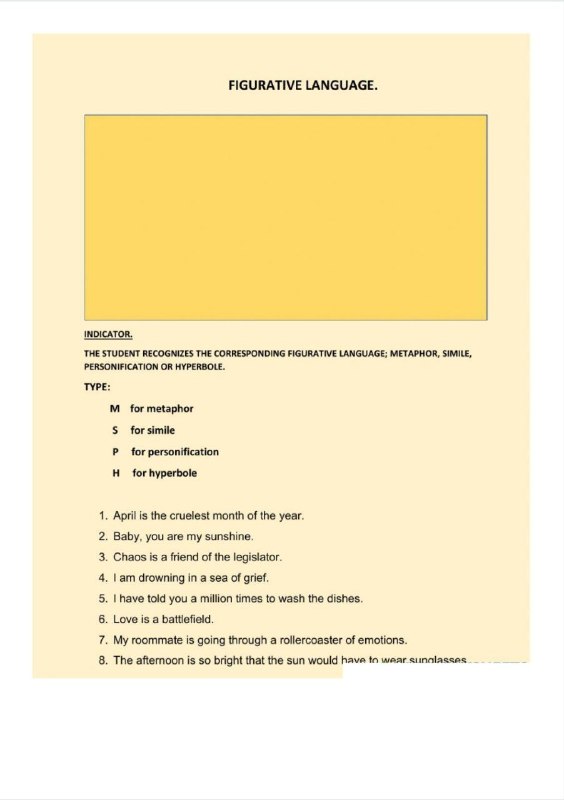| You are here: Almanahj Website ⇒ American curriculum ⇒ 12th Grade ⇒ English ⇒ Term 1 | ||
|---|---|---|
Worksheet about Figurative language | ||
|---|---|---|
| Subject: English | ||
| 12th Grade | ||
| Term 1 | ||
| Year: 2023/2024 | ||
| Size: 263.1KB | ||
| Number of clicks: 780 | ||
| Publish date:October 31, 2023 | ||
| Added by: Eman | ||
| Last download date: 2025-12-21 21:07:20 | ||
| Updated by: Eman9966 on 2023-10-31 09:44:13 | By: theodor charliebarra | |
File info: Figurative language is an important aspect of English language study in grade 12. It involves the use of words and phrases in a non-literal or imaginative way to create vivid and expressive descriptions. Figurative language adds depth, imagery, and emotional impact to written and spoken communication.Here is a description of figurative language in English for grade 12:1. Simile: A simile is a figure of speech that compares two unlike things using "like" or "as." For example, "Her smile is as bright as the sun." 2. Metaphor: A metaphor is a figure of speech that directly describes or equates one thing with another, without using "like" or "as." For example, "He is a shining star." 3. Personification: Personification is a figure of speech in which human attributes or actions are given to non-human entities or objects. For example, "The flowers danced in the breeze." 4. Hyperbole: Hyperbole is an exaggerated statement or claim that is not meant to be taken literally. It is used for emphasis or dramatic effect. For example, "I've told you a million times." 5. Idioms: Idioms are expressions that have a figurative meaning different from their literal meaning. They are unique to a particular language or culture. For example, "Break a leg!" means "Good luck." 6. Alliteration: Alliteration is the repetition of initial consonant sounds in a series of words or phrases, often used for poetic effect. For example, "Peter Piper picked a peck of pickled peppers." 7. Onomatopoeia: Onomatopoeia is the use of words that imitate or suggest the sound associated with the object or action being described. For example, "buzz," "sizzle," or "clang." 8. Symbolism: Symbolism involves the use of objects, characters, or actions to represent abstract ideas or concepts. For example, a dove is often used as a symbol of peace. 9. Irony: Irony is a figure of speech in which the intended meaning is different from the literal or surface meaning of the words. It often involves a contrast between what is expected and what actually happens. 10. Imagery: Imagery refers to the use of vivid and descriptive language that appeals to the senses (sight, sound, taste, touch, smell). It paints a mental picture and enhances the reader's experience. In grade 12, students explore and analyze various examples of figurative language in literature, poetry, speeches, and other forms of written and spoken communication. By understanding and effectively using figurative language, students develop their ability to express themselves creatively, engage readers or listeners, and deepen their understanding and appreciation of literature and language. | ||
| Downloading link Worksheet about Figurative language |
|---|
|
1698745134.pdf
The file is being prepared for download
|
| File images |
|---|
 |
| Another subjects for 12th Grade - Term 1 |
|---|
| Chemistry | Information and comm | Physics | Science | Geology | Environmental Studie | Math | onfo Certainly! Here | subject math |
| Search in American curriculum |
|---|
| Most viewed categories today | |
|---|---|
| Subject | Views |
| English | 53420 |
| Science | 2462 |
| Math | 774 |
| Sum of all categories= 56656 Views | |
| Most viewed articles in the past 30 days |
|---|
| Search by subject, term and grade |
|---|